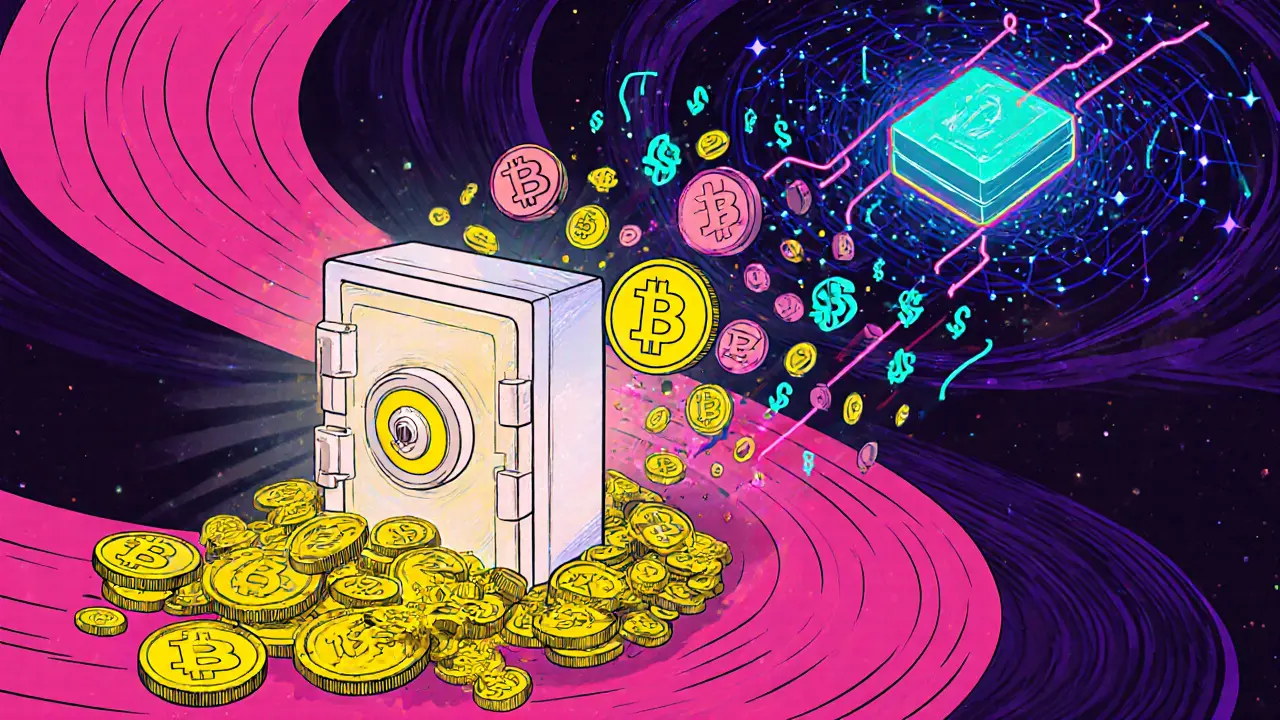Flash Loan Profit Calculator
Calculate whether your flash loan arbitrage opportunity is profitable after accounting for platform fees and gas costs. Based on current DeFi market conditions.
Imagine borrowing millions of dollars without putting up a single cent as collateral, then paying it back instantly in the same transaction. That's what Flash loan a DeFi primitive that lets users take out uncollateralized loans within a single blockchain transaction does. As of October 2025 the space has moved from a wild experiment to a $2 trillion‑plus lending engine on EVM‑compatible chains, but a surge in exploits is forcing developers, regulators, and investors to rethink the next chapter.
How Flash Loans Work
At the core is a Smart contract self‑executing code that runs on a blockchain and can enforce any set of conditions. When a user triggers a flash loan, the contract instantly draws assets from a liquidity pool, runs the user‑defined logic (arbitrage, collateral swap, etc.), and then checks whether the borrowed amount plus a tiny fee (0.09% on Aave the first protocol to launch flash loans in 2020) is returned. If the repayment fails, the whole transaction reverts, erasing every action as if it never happened. This atomicity eliminates default risk for lenders while giving borrowers a risk‑free window to execute complex strategies.
Current Landscape: Adoption and Numbers
By the end of 2024, flash loans accounted for over $2 trillion of on‑chain activity across Ethereum the leading EVM‑compatible blockchain and its sidechains. The fee structure remains low-0.09% on Aave-with other protocols offering similar pricing. The volume is driven mainly by arbitrage traders chasing price gaps between Decentralized exchanges platforms like Uniswap that run on smart contracts. Yet the same data set shows a dark side: flash‑loan‑related hacks cost $92 million in April 2025 alone, a 124% jump from the previous month.
Key Use Cases
- Arbitrage trading: Borrow assets on one DEX where the price is low, sell on another where it’s high, repay the loan, and pocket the spread.
- Collateral swapping: Switch high‑value collateral for a cheaper asset inside a single transaction, freeing up capital for other moves.
- Liquidity provision: Flash‑loan a large sum to become a temporary large liquidity provider, earn fees, then return the loan.
- Governance manipulation: Borrow governance tokens, vote on a proposal that benefits the attacker, then return the tokens-all within one block.
Each scenario hinges on the fact that the loan must be repaid before the block finalizes. If anything goes wrong, the blockchain rewinds the state, protecting lenders but not necessarily the broader ecosystem.

Security Challenges and Attack Vectors
Despite the built‑in safety net, flash loans expose new attack surfaces because they grant massive capital instantly. The most common patterns observed in 2025 include:
- Price manipulation: Attackers use flash loans to inflate or deflate token prices on a vulnerable DEX, then profit from the distorted market.
- Arbitrage exploits: While legitimate arbitrage is benign, hostile actors can flood markets, causing slippage that harms ordinary traders.
- Collateral swapping attacks: By swapping high‑value collateral for low‑value assets, attackers can destabilize lending platforms.
- Governance attacks: Borrowing large token blocks temporarily gives attackers voting power, as seen in the March 2025 KiloEx a DeFi platform that lost $7 million to a flash‑loan exploit incident.
Research from the Bank of Canada Canada’s central bank, which published a staff discussion paper on flash loans in March 2025 warns that most users lack deep technical knowledge, increasing the likelihood of poorly designed contracts that become attack vectors.
Regulatory Outlook
Regulators are waking up to flash loans as both a financial innovation and a systemic risk. The Bank of Canada paper suggests future oversight could include:
- Mandatory security audits for protocols offering flash loans.
- Transaction monitoring requirements to flag unusually large cross‑chain movements.
- Potential user verification steps, which could erode the permissionless ethos.
While no jurisdiction has yet imposed hard rules, the trend points toward tighter scrutiny, especially as institutional players start to explore DeFi exposure.
Technological Evolution and Future Trends
Developers are already building the next generation of flash‑loan tools:
- Cross‑chain flash loans: Projects are experimenting with borrowing on one chain and repaying on another, opening arbitrage between Ethereum, Solana, and Binance Smart Chain.
- AI‑driven strategies: Machine‑learning models can scan dozens of markets in real time, deciding whether a flash‑loan arbitrage is profitable after fees.
- Standardized security frameworks: Open‑source libraries that embed re‑entrancy guards, price‑oracle protections, and fail‑safe rollbacks.
- Insurance products: New DeFi insurers are offering coverage against flash‑loan attacks, turning loss risk into a sellable commodity.
These advances aim to keep the core promise-zero‑collateral borrowing-while plugging the cracks that hackers exploit today.

Opportunities and Risks for Investors
If you’re thinking about allocating capital to flash‑loan platforms, ask yourself:
- Does the protocol publish regular audit reports?
- How deep is the liquidity pool? Low depth can cause huge slippage, erasing profits.
- What is the fee structure compared to competitors? A lower fee increases arbitrage margins but may signal lower security budgets.
- Is there an emerging insurance market that can mitigate potential losses?
Balancing these factors can help you ride the upside while staying protected from the wild swings that have already cost billions this year.
Quick Checklist for Safe Flash‑Loan Participation
- Use platforms with recent, publicly verified audits.
- Monitor on‑chain price feeds for sudden spikes before executing.
- Run your own simulation on a testnet to verify repayment logic.
- Keep transaction fees and gas costs in mind; they can eat thin arbitrage margins.
- Consider buying coverage from a DeFi insurer if you plan large‑scale exploits.
What’s Next?
Flash loans are still in their adolescence. The $2 trillion volume shows demand, yet the $1.7 billion loss tally in early 2025 warns us that security lags behind. Expect more cross‑chain bridges, tighter regulatory eyes, and a budding insurance market. If the community solves the security puzzle, flash loans could become a staple tool not just for traders but also for institutional liquidity managers looking to tap into DeFi efficiency.
What is a flash loan?
A flash loan is an uncollateralized loan that must be borrowed and repaid within a single blockchain transaction. The loan is granted by a smart contract, and if repayment fails the whole transaction is reverted.
Which protocol introduced flash loans?
Aave launched the first flash‑loan product in 2020, setting the fee at 0.09% as of 2025.
Are flash loans risky?
The loan itself carries no default risk because it reverts if not repaid, but the surrounding smart contracts can be vulnerable. Attackers have exploited flash loans to manipulate prices, swap collateral, and hijack governance.
Can I use flash loans on chains other than Ethereum?
Yes. Several EVM‑compatible chains (Binance Smart Chain, Polygon) support Aave’s flash‑loan contracts, and cross‑chain prototypes are under development.
What regulatory changes might affect flash loans?
Regulators may require security audits, transaction monitoring, and possibly user verification for protocols that offer large‑scale flash loans. The Bank of Canada’s 2025 paper hints at tighter oversight.

Write a comment